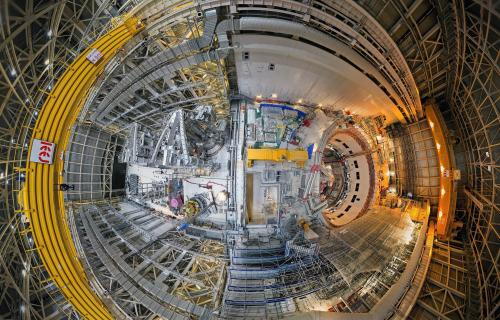At 15 million degrees Celsius the sun’s core is where nuclear fusion occurs, although to replicate this process on earth minimum temperatures of 100 million degrees Celsius are needed. The reason for this large discrepancy in temperatures is because the sun’s gravitational force naturally induces fusion, and without that force on earth a much higher temperature than the sun is needed to create a nuclear reaction. The process involves two atomic nuclei or ions combining to form a single, heavier atomic nucleus. During this fusion process, massive amounts of energy are released. The sun, which is a major source of energy for earth’s oceans, atmosphere, land, and biosphere, generates this energy through nuclear fusion. However, achieving controlled fusion on Earth remains a significant challenge for many reasons. What, though, is so unachievable about fusion and how is it different from fission which we are capable of now? The main difference between the two is splitting vs joining, as we have already established nuclear fusion is the process in which two ions join together. Fission is the splitting of a heavy atom into smaller ones. Both processes do however produce energy because the mass of the remaining nucleus is smaller than the mass of the reacting nucleus, and during this reaction energy is freed. Between the two reactions though, fusion releases a significantly larger amount of energy than fission does per reaction. For example the International Atomic Energy Agency states that “fusion could generate four times more energy per kilogram of fuel than fission.” As for why fusion is a momentous challenge for humans to produce, it is because of the sheer amount of heat and pressure regulation that comes with those high temperatures.
Energy demand is skyrocketing worldwide, prompting scientists and governments to explore a range of solutions to secure a sustainable and reliable energy future. Among these options, nuclear energy-both fission and the emerging field of fusion-has amassed significant attention despite perceptions of high costs and lengthy development timelines. Even requiring great funding to try and create a successful way of continually producing nuclear fusion in the long run will be cheaper than other options, and it is sustainable clean energy. Meaning we will not run out of nuclear fusion and it will not have a negative effect on the environment as many energy options do. The energy produced by nuclear fusion is clean because it does not emit any greenhouse gasses or radioactive waste. Nuclear fusion offers a nearly limitless energy source, unlike fossil fuels, which are finite and contribute significantly to environmental degradation. According to the U.S. Energy Information Administration (EIA), fossil fuels are responsible for 74% of global carbon emissions, a major driver of climate change(EIA, 2023). This stark contrast highlights the potential of fusion to provide a cleaner, more sustainable energy future. Nuclear fusion relies on isotopes, which are abundant and can be extracted from water and lithium. In fact, the oceans contain enough deuterium to meet global energy needs for billions of years. Adding to its appeal nuclear fusion at first be an investment, as the cost for reactors are high, but once operational experts estimate that it could be cheaper than many existing energy sources. The World Nuclear Association, in the article “Nuclear Fusion and the Energy Future” (2021), remarks that “Fusion has the potential to be an economic game-changer. Once operational, fusion energy could be cheaper than many existing energy sources. The cost of generating fusion electricity could be as low as $50 per megawatt-hour (MWh), compared to approximately $100–$150 per MWh for solar or wind energy.”
In December 2022, scientists at the U.S. National Ignition Facility(NIF) achieved a historic milestone by producing more energy from a fusion reaction than was used to initiate it, a breakthrough once thought unattainable. This achievement, along with advances in magnetic confinement and laser-driven fusion, has brought the dream of sustainable, clean energy closer to reality. These technological leaps are now making it possible to reach energy yields that were previously considered impossible, such as generating net positive energy from fusion reactions
One of the most significant achievements in recent years was made by the ITER or International Thermonuclear Experimental Reactor. Located in France, the ITER is a collaboration between 35 nations. The ITER has made notable progress with its magnetic confinement technology, which uses powerful magnetic fields to contain the superheated plasma where fusion reactions occur.
In 2021, the ITER achieved a vital milestone by reaching plasma temperatures of over 150 million degrees Celsius, which is approximately ten times hotter than the sun’s core. Experts believe this advancement is crucial for demonstrating that fusion can be maintained long enough to produce more energy that is required to sustain the reaction, a key requirement for practical fusion energy. According to ITER’s project leaders this breakthrough moves us closer to the goal of achieving “net positive energy” from fusion by the late 2020a, which could revolutionize global energy production and reduce our dependence on fossil fuels.
Although ITER has not yet achieved “break-even”—a term that describes when the energy produced by the fusion reaction equals the energy used to create the reaction—experts in the field view it as one of the most crucial projects advancing fusion energy. According to Dr. Bernard Bigot, Director-General of the ITER Organization, Iter is “a vital step toward demonstrating the feasibility of fusion as a large-scale and carbon-free source of energy.” While ITER leads in magnetic confinement fusion, other key players in the field, such as the U.S. National Ignition Facility (NIF) and private companies like Commonwealth Fusion Systems, are also making significant strides in laser-driven fusion and new fusion technologies. Their combined efforts are propelling the global push to make fusion energy a reality.
Another influential milestone came from the National Ignition Facility (NIF) in the United States, which successfully achieved fusion ignition in 2022. This event is where more energy was produced by the fusion reaction than was absorbed by the fuel. This is a historic breakthrough in laser driven fusion experiments. To achieve this landmark, the NIF used intense laser beams to compress hydrogen isotopes to the point where they undergo fusion. Providing another promising route towards achieving net positive energy from fusion, the NIF is another key player in fusion energy.
Both the ITER and NIF facilities are government funded, but companies like Commonwealth make up the private sector in fusion. Another notable private sector company is Tokamak Energy, a UK based fusion energy company that has been improving its compact fusion reactors. Tokamak Energy’s approach utilizes smaller, more cost effective machines designed to contain plasma using magnetic fields, otherwise known as tokamaks. They aim to make fusion energy commercially viable within the next few decades. Private sector facilities are also key players in the world of fusion because they are crucial for speeding up the development of fusion energy and potentially reducing the high costs associated with fusion reactors.
Nuclear fusion offers the potential for virtually limitless, clean energy with no carbon emissions, using abundant and sustainable fuels. While challenges remain, its benefits make it a promising alternative to fossil fuels, driving significant global investment and research. One of the most compelling reasons why nuclear fusion is seen as the “holy grail” of energy production is because of its clean nature. Unlike fossil fuels, fusion does not release greenhouse gasses, making it a critical toll in the fight against climate change. Additionally, fusion generates less radioactive waste than nuclear fission, and the waste it does produce is far less hazardous. The reason behind this is that the primary fuel for fusion, deuterium and tritium, does not create long lived radioactive byproducts. In fact, the waste generated by fusion is expected to be much easier to manage compared to the waste produced by current fission reactors.
Fusion’s primary fuel sources are abundant and can be harvested from seawater and lithium-rich materials, this makes fusion not only renewable but also could provide our world with virtually unlimited energy. Furthermore, fusion could eventually provide energy at costs lower than those of current renewable energy sources like wind or solar. According to a 2023 report by the IEA, fusion energy could become competitive with other low-carbon technologies by the 2030s, as technology advancements and economies of scale reduce costs. Additionally, with global population growth and rising energy demand, fusion is increasingly viewed as a promising solution to meet future energy mends.
While fusion holds enormous potential, its advancement comes with significant risks as well, a main concern being theoretical weaponization of fusion technology. Fusion reactions, while much cleaner and less dangerous than fission, still release massive amounts of energy, and the technology required to achieve fusion could potentially be adapted for weaponization purposes. This poses a significant global risk if unauthorized individuals or hostile states were to gain access to these technologies. Nuclear fusion research centers could be vulnerable to cyberattacks as the data generated by fusion research are invaluable. Securing these facilities from cyber threats and ensuring the tech is not misused will be an ongoing challenge.
Along with all of these tangible risks, geopolitical questions arise as fusion has the potential to reshape global energy dynamics. Some of the most pressing questions surrounding fusion energy include who will control its production and how access to this sustainable resource will be regulated. These issues raise complex ethical concerns, such as the potential for unequal access to energy and the risks of monopolies controlling a critical global resource. Since fusion offers such an abundant and sustainable source of energy, there are growing concerns about its distribution and equitable access. These dilemmas must be addressed to prevent any aggravating of existing global inequalities. Fusion could shift power dynamics between nations, and lead to new forms of competition or even conflict over access to fusion energy technology. Concerns about the potential military use of nuclear fusion, such as the development of advanced weapons or energy sources for strategic warfare, raise the risk of escalating conflicts and global instability, making its regulation and control a pressing matter.
Despite ongoing doubts about whether the risks of fusion energy are worth the rewards, the path forward lies in balancing progress with security. Achieving this balance will require carful regulation to ensure that fusion’s transformative potential is harnessed responsibly, without risking significant harm to public safety or the environment. International treaties are one way to approach these safety issues and could provide a framework for global cooperation. For example, the Nuclear Non-Proliferation Treaty(NPT), which governs the peaceful use of nuclear technology, could serve as a model for regulating fusion energy, ensuring that it is developed and deployed in a way that benefits all nations while minimizing risks.
Nuclear fusion has the potential to revolutionize global energy systems, offering a clean, virtually limitless source of power. However, like all powerful technology, fusion comes with its risks. While the technological advancements in magnetic confinement and laser-driven fusion bring us closer to sustainable energy, the risks associated with fusion—such as political control over the technology and the security of fusion facilities—must not be overlooked. For instance, ensuring that fusion technology is not misused for weapons production or concentrated in the hands of a few powerful nations will require robust international agreements and effective regulatory frameworks. By balancing innovation with careful management, fusion energy can become a transformative force that addresses both our growing energy needs and global security concerns.







